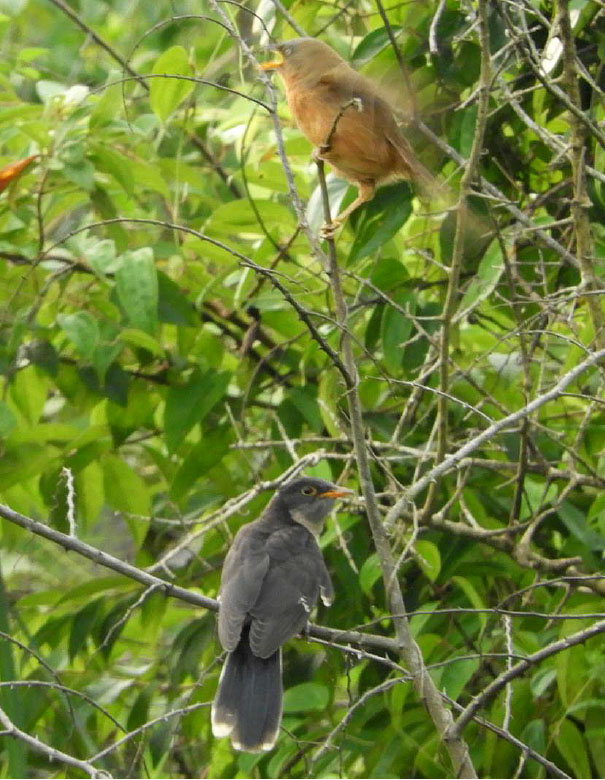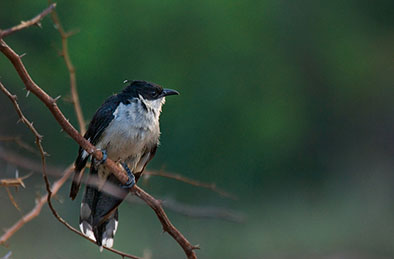Pied Cuckoo or Jacobin Cuckoo Clamator jacobinus is one among the several cuckoo species exhibiting interspecific brood parasitism. They are known as the ‘harbingers of monsoon’ in Indian folklore as there is a mythical belief that they bring rain. C. j. pica/serratus and C. j. jacobinus are the two subspecies of Pied Cuckoo that occur in India. C. j. pica/serratus is found in north India from April or May to September and November. They breed during this period and vanish by early dry season (Payne 2005) whereas, C. j. jacobinus, which is a local migrant in south India (Gaston 1976), breeds in summer and stays on in winter (Payne 2005). Pied Cuckoo parasitizes Common Babbler Argya caudata, Jungle Babbler Turdoides striata, Large Grey Babbler Argya malcolmi, Yellow-billed Babbler Turdoides affinis, Fiscal flycatcher Melaenornis silens, Rufous Babbler Argya subrufa and Laughingthrush spp. (Nahid et al. 2016). They are uncommon in Kerala and rare in the northern districts of Kannur and Kasaragod (Sashikumar et al. 2011). In Kerala, Pied Cuckoo inhabits lightly wooded areas with dry and moist deciduous biotope and breeds in the nests of Rufous Babblers and Yellow-billed Babblers (Sashikumar et al. 2011). Sashikumar et al. (2011) concluded that Pied Cuckoos observed in Kerala exclusively during monsoon might be C. j. pica/serratus and others are C. j. jacobinus.
Central University of Kerala (12.3959°N, 75.0919°E) stretches over 350 acres of land in Tejaswini hills, Periye in Kasaragod district of Kerala. It is known as the ‘Land of Babblers’ among the local birders due to the presence of many resident babbler species including Yellow-billed Babbler, Rufous Babbler, Jungle Babbler (Family Leiothrichidae), Puff-throated Babbler Pellorneum ruficeps (Family Pellorneidae) and Dark-fronted Babbler Rhopocichla atriceps (Family Timaliidae). Among these babbler species, Rufous Babbler and Yellow-billed Babbler are the most numerous and their breeding had been recorded during the period of the south-west monsoon in 2017. Pied Cuckoo was also observed there during the monsoon season as a migrant/local migrant.
 In the morning of 8 September 2017, around 07:15hrs, a juvenile fledgling Pied Cuckoo was observed along with an 8-member Rufous Babbler group on the eastern side of the campus, which is basically a patch of grassland surrounded by thorny shrubs and trees. Characteristically, the bird had a small crest and pale beak. Overall, it had a dull, sooty black plumage and white under parts suffused with grey. White wing patches were present but they were rather inconspicuous. The breast was tawny and throat was more greyish. The fledgling was seen perched on shrubs and small trees including Ziziphus sp. and Acacia auriculiformis.
In the morning of 8 September 2017, around 07:15hrs, a juvenile fledgling Pied Cuckoo was observed along with an 8-member Rufous Babbler group on the eastern side of the campus, which is basically a patch of grassland surrounded by thorny shrubs and trees. Characteristically, the bird had a small crest and pale beak. Overall, it had a dull, sooty black plumage and white under parts suffused with grey. White wing patches were present but they were rather inconspicuous. The breast was tawny and throat was more greyish. The fledgling was seen perched on shrubs and small trees including Ziziphus sp. and Acacia auriculiformis.
At first, the juvenile Pied Cuckoo had been hiding inside the thickets alone and showed very little movement. But when the foster group approached, it took small hopping flights, came out of the thicket and produced intense and continuous food begging call wee, wee, weee. The call grew louder and more frequent as the babblers came closer. The fledgling incessantly quivered its wings up and down along with the begging call. Its bright orange gape was wide open and a single individual of the babbler group fed the fledgling. Interestingly, there was no juvenile babbler in the group. The babblers were very noisy and kept calling alarmingly for a few minutes, probably due to our presence. Finally, the group took short flights into the nearby bushes followed by the juvenile Pied Cuckoo and disappeared.
References
Gaston, A. J., 1976. Brood parasitism by the pied crested cuckoo Clamator jacobinus. The Journal of Animal Ecology 45(2): 331-348.
Nahid, M. I., Begum, S., & Feeroz, M. M., 2016. Brood parasitic cuckoos and their hosts in Jahangirnagar University Campus. Indian BIRDS 12(2 & 3): 64-69.
Payne, R. B., 2005. The cuckoos. Pp. 320-324. Oxford University Press.
Sashikumar, C., Praveen J., Palot, M. J., & Nameer, P. O., 2011. Birds of Kerala: status and distribution. 1st ed. Pp. 382-384. Kottayam, Kerala: DC Books.
